Just arrived in Edinburgh and, as always – it’s lovely! Great weather, lovely people – what’s not to love?
 Looking forward to everyone getting here. More pictures next time and on my facebook page. Maybe you can join us next time?
Looking forward to everyone getting here. More pictures next time and on my facebook page. Maybe you can join us next time?

Just arrived in Edinburgh and, as always – it’s lovely! Great weather, lovely people – what’s not to love?
 Looking forward to everyone getting here. More pictures next time and on my facebook page. Maybe you can join us next time?
Looking forward to everyone getting here. More pictures next time and on my facebook page. Maybe you can join us next time?
Well, you made it – Week Five of Boot Camp! You should be proud of yourself and your hard work. This gives you a foundation to keep building your practice and to refine it to meet your needs. Those needs will likely change as you develop as a harper, but the fundamentals stay the same. So, keep at it and finish strong!
 Stretch – Small Shoulder Rolls are relatively easy, but because we use our shoulders more than we know, you might be tighter in the shoulder than you’d expect.* Begin by sitting (or standing) upright, head up, shoulders down. Place your right fingertips on your right shoulder and your left fingertips on your left shoulder with your arms in front of your chest. Your elbows should be close to your waist. Now, rotate your arms to the outside and “draw circles” with your elbows. Keep your head up. Take your time – go slowly and carefully. If your shoulders are tight, this may be challenging. Repeat three to five times. This stretch can be performed before, after, and during your practice.
Stretch – Small Shoulder Rolls are relatively easy, but because we use our shoulders more than we know, you might be tighter in the shoulder than you’d expect.* Begin by sitting (or standing) upright, head up, shoulders down. Place your right fingertips on your right shoulder and your left fingertips on your left shoulder with your arms in front of your chest. Your elbows should be close to your waist. Now, rotate your arms to the outside and “draw circles” with your elbows. Keep your head up. Take your time – go slowly and carefully. If your shoulders are tight, this may be challenging. Repeat three to five times. This stretch can be performed before, after, and during your practice.
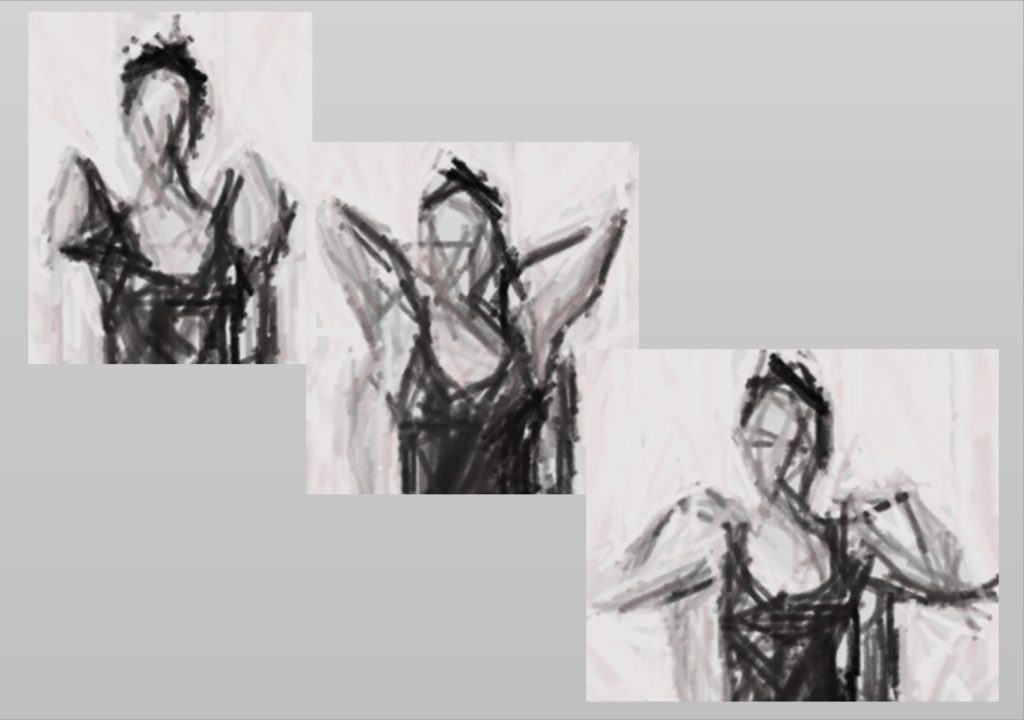 Technique – Dall-ing. Not Daaaahl-ing, Dall-ing. Don’t roll your eyes, I can make up words if I need them! Dall is the Gaelic word for blind – and if the harpers of old could play without seeing, you can play without looking. Yes, it can be scary but, as with everything – if you practice it, you will get better at it. And since most people are primarily visual, giving your other senses a chance to be in charge will change your perspective and will improve your playing whether you’re looking at the harp or not. To practice Dalling, simply close your eyes – and keep them closed! Start by playing scales – make your initial placement and then close your eyes and play. Pay attention – where are your arms? Where are you stretching? How far do your fingers need to move? Once you’ve got that down (and after all – you’ve been playing scales – they’re so easy you can do them with your eyes closed!) move on to the intervals we did in week one (first left hand, then right hand, then hands together). And once that’s easy, move on to playing tunes you know well. All the time you’re playing, you are training yourself to listen, to feel (the strings on your fingers, the harp in your arms, the stretch or bend in your elbow) all those things tell you something about where you are on the harp. Don’t get discouraged – you can do this!
Technique – Dall-ing. Not Daaaahl-ing, Dall-ing. Don’t roll your eyes, I can make up words if I need them! Dall is the Gaelic word for blind – and if the harpers of old could play without seeing, you can play without looking. Yes, it can be scary but, as with everything – if you practice it, you will get better at it. And since most people are primarily visual, giving your other senses a chance to be in charge will change your perspective and will improve your playing whether you’re looking at the harp or not. To practice Dalling, simply close your eyes – and keep them closed! Start by playing scales – make your initial placement and then close your eyes and play. Pay attention – where are your arms? Where are you stretching? How far do your fingers need to move? Once you’ve got that down (and after all – you’ve been playing scales – they’re so easy you can do them with your eyes closed!) move on to the intervals we did in week one (first left hand, then right hand, then hands together). And once that’s easy, move on to playing tunes you know well. All the time you’re playing, you are training yourself to listen, to feel (the strings on your fingers, the harp in your arms, the stretch or bend in your elbow) all those things tell you something about where you are on the harp. Don’t get discouraged – you can do this!
Practice Element – Taking the time. We are all busy. And we sometimes have difficulty cramming all the things we think are important into our days. And its easy to let practicing slip away. Or to get time, but to give our practice short shrift by just playing and not doing mindful work. All of those get in our way. Start by being honest about when you will practice and how much time you have practice. Do not get impatient and want to be able to play something immediately, if not sooner. Or get wrapped up in the illusion that someone else is performing better, faster, stronger than you are. Or be confident that you’re not getting any better. Acknowledge what that amount of time will mean to your in terms of how fast you will be able to prepare new material – and accept that. work from where you are, with what you have to achieve what you want. Give yourself the time to make things happen – in your own time.
Boot Camp – Five Weeks to Better is coming to a close. But the work continues. Keep practicing – do the things that help you move forward and enjoy the journey. At this point, you’re ready to take on the summer! Enjoy it – and let me know what you do and how this Boot Camp helped you be prepared!
*Remember that I’m not that kind of doctor, so please be careful, work within your own abilities (which isn’t to say don’t stretch yourself but also, don’t hurt yourself!). Be careful and only do what you can do. This blog provides general information about trying to stay health and other subjects related to playing the harp. All the content provided in this blog, and in any linked materials, is not intended to be, and should not be construed to be, medical advice. If you have a medical concern, consult with an appropriately-licensed physician or other
health care worker. Never disregard professional medical advice or delay seeking it because of something you have read on this blog or in any linked materials. If you think you may have a medical emergency, call your doctor or 911 immediately. The views expressed on this blog and website have no relation to those of any academic, hospital, practice or other institution with which the author is affiliated. Don’t be thick – these are just suggestions – take care of you!
If building a habit takes 21 days, then you’re on your way to a solid practice habit. And although sometimes it can feel like liver and durian on the same plate, you know it’s good for you – so stick with it – we’re almost there!
 Stretch – Hand yawns: Few things are as satisfying as a good long yawn. It looks funny – but it feels good! These we’re going to spread that satisfaction to your hands. These are a fun, quick, and can be done just about anywhere. Start with your hand closed, fingers together. Take a deep breath. Now spread your fingers as wide as you can.* Reach with each finger. Hold your hand open like that for 5 – 10 seconds. Keep breathing. Do each hand 3 – 5 times. Fully relax your hand between stretches. You can do this stretch before and/or after your practice, while you’re on the phone, while driving (of course, don’t let go of the steering wheel!), or while waiting in line in the grocery – the possibilities are endless.
Stretch – Hand yawns: Few things are as satisfying as a good long yawn. It looks funny – but it feels good! These we’re going to spread that satisfaction to your hands. These are a fun, quick, and can be done just about anywhere. Start with your hand closed, fingers together. Take a deep breath. Now spread your fingers as wide as you can.* Reach with each finger. Hold your hand open like that for 5 – 10 seconds. Keep breathing. Do each hand 3 – 5 times. Fully relax your hand between stretches. You can do this stretch before and/or after your practice, while you’re on the phone, while driving (of course, don’t let go of the steering wheel!), or while waiting in line in the grocery – the possibilities are endless. 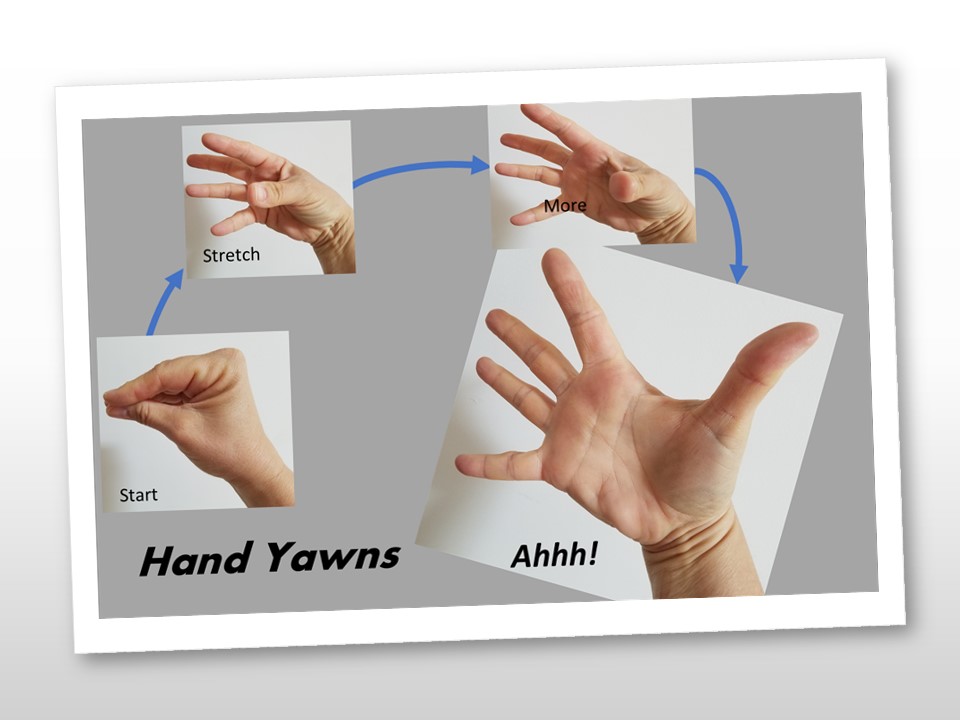
Technique – Lever changes: You might not think about lever changes as needing a lot of practice, but because they are relatively infrequent, you do need to practice doing them efficiently and smoothly. Making a lever change needs to be like all the other movements you make – on time, quiet, accurate, and consistent. Let’s focus on the left hand because, while you can do right hand lever changes, you will want to avoid those as much as possible! Today we’ll focus on changing a single lever. The same process occurs when you modulate or change a lot of levers at the same time). We’ll do this in ¾ and you’ll play a note, engage the lever, play a note, play a note, disengage the lever, play a note – try that until you get the hang of it. Then you can work on playing this exercise:
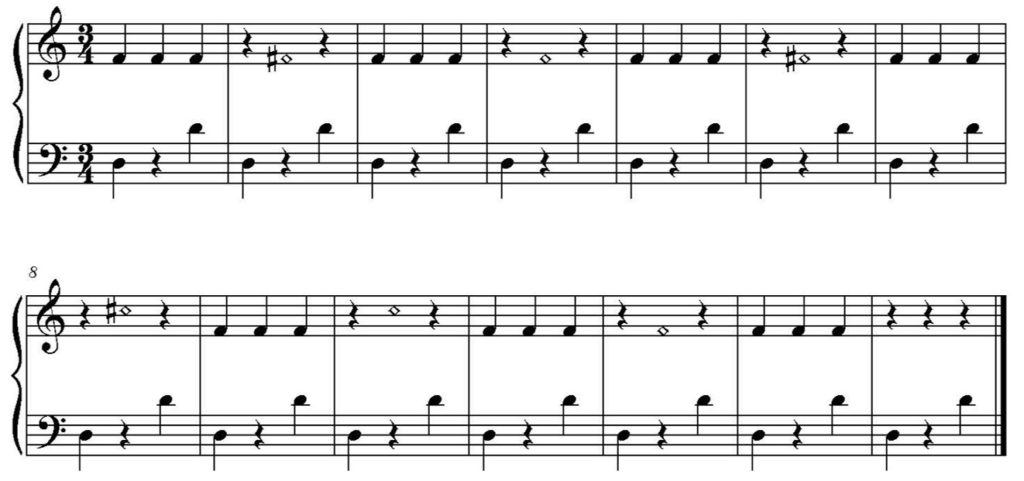 In effect, you start in C tuning and by the end you have moved yourself to D tuning. Move carefully and deliberately. In the left hand, (beat 1) play the D, come off and (beat 2) engage the lever, (beat 3) return to the strings and play the D. You can do any key you like – remember we’re only trying to change one lever. Go slowly at first. Be careful, stay in rhythm, be accurate (get the right lever!), and be thorough (fully engage the lever). As you get more comfortable, pick up the tempo, but do not accept sloppy. As you get the hang of it, you can move on to modulation (changing from one key to another – in this example, changing all the Cs and Fs on the harp – but get changing one down before you try that!). Once you get the hang of it, it’s easy (but still takes practice).
In effect, you start in C tuning and by the end you have moved yourself to D tuning. Move carefully and deliberately. In the left hand, (beat 1) play the D, come off and (beat 2) engage the lever, (beat 3) return to the strings and play the D. You can do any key you like – remember we’re only trying to change one lever. Go slowly at first. Be careful, stay in rhythm, be accurate (get the right lever!), and be thorough (fully engage the lever). As you get more comfortable, pick up the tempo, but do not accept sloppy. As you get the hang of it, you can move on to modulation (changing from one key to another – in this example, changing all the Cs and Fs on the harp – but get changing one down before you try that!). Once you get the hang of it, it’s easy (but still takes practice).
Practice element – Counting: Counting is essential. No matter how you feel about it, music is applied mathematics, so whether you’ll admit it or not, you should always be counting. And although you’ve been counting since you were young, you s-t-i-l-l need to practice counting your music. The challenge is to have enough spare mental capacity to ensure you are counting even when things are tough. And, lest you think that all the harp hero’s you’ve watched on stage aren’t counting – fie – they just have way more practice than you, so they are at the end of this paragraph – and you might be right here àStart by counting aloud. No really – out loud – so everyone can hear you. You might notice that this is difficult. It’s hard to talk (count out loud) and play and think about what comes next and everything else! And it won’t get any easier unless you practice it. When you can count out loud while staying on tempo and on rhythm and while playing the right notes, then you can, as always, pick up the tempo a little. And as always, when you fumble, slow down and work it some more. When you can play and count out loud successfully, then you can move to internalize your counting more. This is more challenging than it sounds – the next step is to say the numbers without saying them out loud – still a bit of extra work. From there you can verbalize the counting inside your head (and yes, you should still be able to “hear” yourself counting, only now, you’re the only one who can hear it!). This can be a slow and painful process, but it’s so worth the work.
We have only one week remaining in this summer’s boot camp – one more week to work hard to be ready for all the summer fun that awaits – hope you’re finding it useful and as always, I’d love to know how you’re coming along, what was helpful, what was hard to follow, and how you are noticing improvement in your practice and playing!
*Remember
that I’m not that kind of doctor, so please be careful, work within your own abilities (which isn’t to say don’t stretch yourself but also, don’t hurt yourself!). Be careful and only do what you can do. This blog provides general information about trying to stay health and other subjects related to playing the harp. All the content provided in this blog, and in any linked materials, is not intended to be, and should not be construed to be, medical advice. If you have a medical concern, consult with an appropriately-licensed physician or other health care worker. Never disregard professional medical advice or delay seeking it because of something you have read on this blog or in any linked materials. If you think you may have a medical emergency, call your doctor or 911 immediately. The views expressed on this blog and website have no relation to those of any academic, hospital, practice or other institution with which the author is affiliated. Don’t be thick – these are just suggestions – take care of you!
If you have been playing along at home, you have probably already started seeing differences in your practice and your playing. I hope this encourages you to keep at it. Consistency may be the most important practice element of all, and it is certainly one of the most underrated!
As before, you can focus on this week’s activities or you can add this on top of the previous weeks – whatever works well for you.*
 Stretch – Bow, no, b-o-w! Because so many of us are dedicated (or foolish) we may sit at the harp for long stretches of time. Many do not realize how much work this can be for the hips, back, legs, and core. One soothing, relaxing stretch is to bow. You can do this from the bench or while standing. From the bench, sit away from the harp and with both feet flat on the floor and knees apart (wider than if you were playing), hands resting on your thighs, hinge forward from the hip with your back flat (this is easiest if you keep your head up). Move slowly and deliberately into the stretch. Keep your core strong. Go as deeply into the stretch as you are able. Breathe. Now, slowly lower your head, round your back and let your arms dangle. Breathe! You can stay here as long as you like (and as long as you continue to breathe). When you’re ready, s-l-o-w-l-y roll up to your starting position. If you prefer to stand, start with your feet shoulder width apart, weight balanced, knees soft, and hinge forward as above. Be sure to monitor and maintain your balance.
Stretch – Bow, no, b-o-w! Because so many of us are dedicated (or foolish) we may sit at the harp for long stretches of time. Many do not realize how much work this can be for the hips, back, legs, and core. One soothing, relaxing stretch is to bow. You can do this from the bench or while standing. From the bench, sit away from the harp and with both feet flat on the floor and knees apart (wider than if you were playing), hands resting on your thighs, hinge forward from the hip with your back flat (this is easiest if you keep your head up). Move slowly and deliberately into the stretch. Keep your core strong. Go as deeply into the stretch as you are able. Breathe. Now, slowly lower your head, round your back and let your arms dangle. Breathe! You can stay here as long as you like (and as long as you continue to breathe). When you’re ready, s-l-o-w-l-y roll up to your starting position. If you prefer to stand, start with your feet shoulder width apart, weight balanced, knees soft, and hinge forward as above. Be sure to monitor and maintain your balance.
Technique – Ornaments. Sorry, this is not the fun of decorating but the work of adding ornaments to tunes. To practice ornamentation, you need control. To get light, accurate, beautiful ornaments – you must control your fingers and the strings to control the weight and length of the notes. As you know, ornaments are light, quick, and ahead of the beat. To get them light and quick, practice them. Today we are looking at cuts (you can, of course, extend this to other ornaments, but let’s focus here for now). This is a variation of the intervals you did in Boot Camp Week 1. Select your favorite key and scale and work your way, in intervals of a second, from root to octave and back again. Play the first note (the cut) just ahead of the beat with the second note occurring on the beat (because I’m sure you are counting, even if playing scales!). Be careful to work slowly and make the first note light and quick; the second will be heavier and have all the weight of a proper note. Quicklight/HEAVYFULL. When you have it in the right hand (where you are going to use it most) do it in the left hand. While you might not ever make an ornament in the left hand, practicing that level of control will only serve you well. Once you have that down, move to different intervals (use the 3rd, the 4th, the 5th, etc.) and learn which ones you like best. If some are more challenging than others – well, now you know where you need to direct more work!
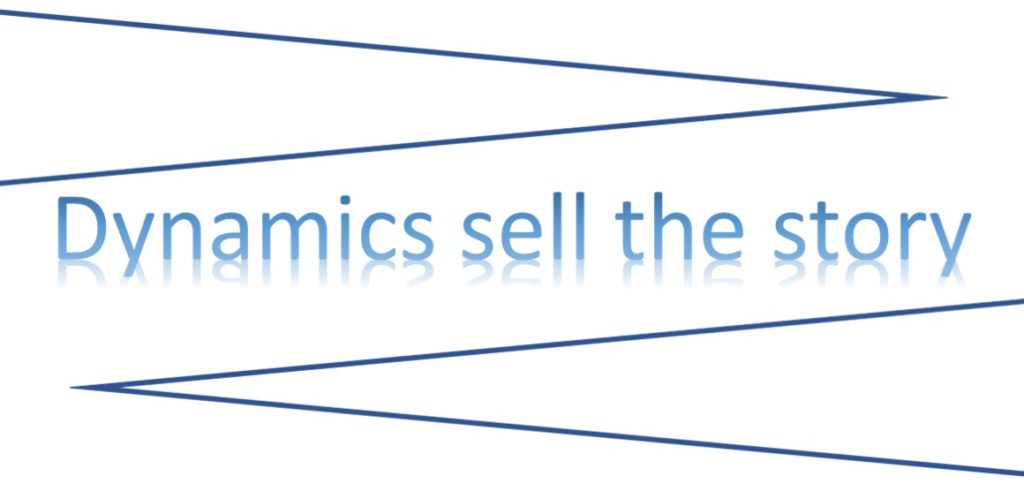 Practice Element – Dynamics. Since we’re already working on control – let’s extend that to dynamics. Being in control of the harp gives you a better firmament from which to build more musicality and presentation. Dynamics often get short shrift or just forgotten. Now this might be forgivable (m-i-g-h-t) in a set of dance tunes, it is unforgiveable in songs and airs or any classical music. The dynamics are one of the easiest things you can do to help you sell the story, so they are definitely an important part of playing. The point of injecting dynamics is to enhance the inflection of the tune. Dynamics don’t always have to be dramatic – even small changes really make an impact to your listeners. To start practicing dynamics, first think about the markings for crescendo/decrescendo – a very long arrow – that’s how you want to play. Let’s stick to a major scale and play it with those arrows – start very small and build the sound as you go up to the octave. Each note should be just noticeably louder than the note before. On the way down, do the opposite with each note just noticeably softer than the previous. This week there’s a twofer – after you’ve done those scales, follow it with a three-scale – place your fingers for the scale and play each note three times – p, mf, f (always with the same finger) up the octave and f, mf, p on the way back down. When you’ve mastered one hand, move on to the other, and then do both together – always careful to assure you have the volume you intended. Too easy? This time do the same scale but as you go up play f, mf, p (and when it’s too easy go to four fff, mf, mp, ppp) and come down at p, mf, f (or ppp, mp, mf, fff). Bored? Now play the scales with two hands – play the left hand p and the right hand f, then switch. Be careful but gentle – and do the work you need to do. Soon you’ll have the skill to be as dynamic and dramatic as you wish – for each tune – exactly as you mean to deliver it!
Practice Element – Dynamics. Since we’re already working on control – let’s extend that to dynamics. Being in control of the harp gives you a better firmament from which to build more musicality and presentation. Dynamics often get short shrift or just forgotten. Now this might be forgivable (m-i-g-h-t) in a set of dance tunes, it is unforgiveable in songs and airs or any classical music. The dynamics are one of the easiest things you can do to help you sell the story, so they are definitely an important part of playing. The point of injecting dynamics is to enhance the inflection of the tune. Dynamics don’t always have to be dramatic – even small changes really make an impact to your listeners. To start practicing dynamics, first think about the markings for crescendo/decrescendo – a very long arrow – that’s how you want to play. Let’s stick to a major scale and play it with those arrows – start very small and build the sound as you go up to the octave. Each note should be just noticeably louder than the note before. On the way down, do the opposite with each note just noticeably softer than the previous. This week there’s a twofer – after you’ve done those scales, follow it with a three-scale – place your fingers for the scale and play each note three times – p, mf, f (always with the same finger) up the octave and f, mf, p on the way back down. When you’ve mastered one hand, move on to the other, and then do both together – always careful to assure you have the volume you intended. Too easy? This time do the same scale but as you go up play f, mf, p (and when it’s too easy go to four fff, mf, mp, ppp) and come down at p, mf, f (or ppp, mp, mf, fff). Bored? Now play the scales with two hands – play the left hand p and the right hand f, then switch. Be careful but gentle – and do the work you need to do. Soon you’ll have the skill to be as dynamic and dramatic as you wish – for each tune – exactly as you mean to deliver it!
Hang in there – you’re more than half the way there and you’re building a solid practice habit!
*Remember that I’m not that kind of doctor, so please be careful, work within your own abilities (which isn’t to say don’t stretch yourself but also, don’t hurt yourself!). Be careful and only do what you can do. This blog provides general information about trying to stay health and other subjects related to playing the harp. All the content provided in this blog, and in any linked materials, is not intended to be, and should not be construed to be, medical advice. If you have a medical concern, consult with an appropriately-licensed physician or other health care worker. Never disregard professional medical advice or delay seeking it because of something you have read on this blog or in any linked materials. If you think you may have a medical emergency, call your doctor or 911 immediately. The views expressed on this blog and website have no relation to those of any academic, hospital, practice or other institution with which the author is affiliated. Don’t be thick – these are just suggestions – take care of you!
So, you made it through Bootcamp Week One! If you were able to insert this into your practice – good for you! And remember that you are doing it for you, so even if you only get in a couple of days – you’re making a better you!
This week, you can continue the stretch, technique and practice element you learned last week, you can do this week’s set, or you could add them together. It’s up to you!  Stretch – Cozy Corner. Stand with both feet on the floor, weight balanced between them near an “outside corner” (the kind that point at you). You can also use a doorway. Keep yourself lifted, head up, back comfortable and straight, shoulders relaxed. With your arm out to your side, place your forearm on the wall. Slowly draw in a deep breath into your abdomen, hold for a moment and slowly lean into your corner, turn away, and let your breath out. Do this for a couple of breaths, and then do the other side. Be relaxed and be careful to be in control so you don’t hurt your shoulders. Do not stretch farther than your flexibility!*
Stretch – Cozy Corner. Stand with both feet on the floor, weight balanced between them near an “outside corner” (the kind that point at you). You can also use a doorway. Keep yourself lifted, head up, back comfortable and straight, shoulders relaxed. With your arm out to your side, place your forearm on the wall. Slowly draw in a deep breath into your abdomen, hold for a moment and slowly lean into your corner, turn away, and let your breath out. Do this for a couple of breaths, and then do the other side. Be relaxed and be careful to be in control so you don’t hurt your shoulders. Do not stretch farther than your flexibility!*
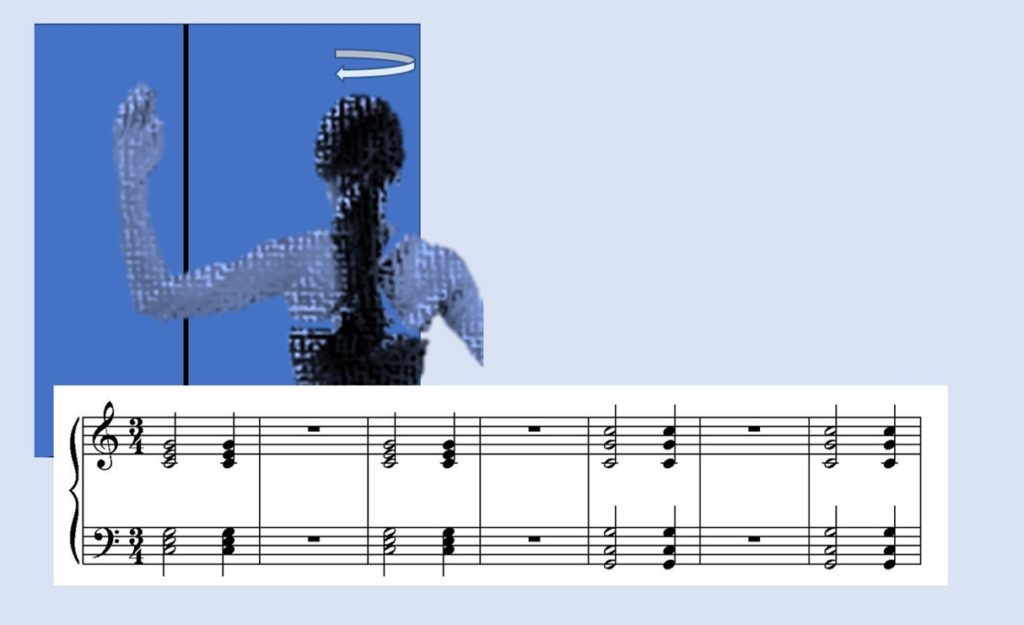 Technique – Placing. One challenging thing is to learn to land on strings that are already vibrating so as to stop them, but not too quickly! If you don’t stop the strings, you get horrible buzzes. But if you stop the strings too quickly you get noise. This week, to practice placing, we’re going to use chords. Start in your favorite major key and counting in 3. Wang off a really loud I chord on the 1 beat. Use the second beat to admire your handiwork (or to be slightly more successful, use the time to figure out your next move!). On the third beat, land back on that same chord – quietly, gently but firmly. Watch your fingering and use it for both the first and third beats. Play the chords you are comfortable with. Just beginning? Stick to I-III-V chords. More advanced? Do I-V-VIII chords. Really advanced – do something jazzy – but make sure the third beat is playing the same notes as the first! Work slowly and carefully to assure you’re actually stopping the strings like you mean to (don’t work on luck!). Once you’ve got the hang of it, work your way up the octave repeating the chords. Go slowly and carefully. No buzzing, no misses (errors), stay on the beat, make smooth transitions, and mind your hand and arm position and that your wrists are in a neutral position. No tension! Keep your shoulders down and your head up. Start with each hand and when these are good, go on to both hands. If this is too easy, you know the drill – place your hands and then close your eyes. Still too easy? Start with your eyes closed to find the start point. Again, do not accept a marginal effort – “good enough” isn’t. Do the work – for you. Not getting what you expect? Slow down more. Go only as fast as you can do it correctly. Do not rush. Remember to enjoy the sound, to feel the harp, and enjoy the experience! This can be difficult, so don’t sweat it if it takes a little practice – you will get there if you keep working on it!
Technique – Placing. One challenging thing is to learn to land on strings that are already vibrating so as to stop them, but not too quickly! If you don’t stop the strings, you get horrible buzzes. But if you stop the strings too quickly you get noise. This week, to practice placing, we’re going to use chords. Start in your favorite major key and counting in 3. Wang off a really loud I chord on the 1 beat. Use the second beat to admire your handiwork (or to be slightly more successful, use the time to figure out your next move!). On the third beat, land back on that same chord – quietly, gently but firmly. Watch your fingering and use it for both the first and third beats. Play the chords you are comfortable with. Just beginning? Stick to I-III-V chords. More advanced? Do I-V-VIII chords. Really advanced – do something jazzy – but make sure the third beat is playing the same notes as the first! Work slowly and carefully to assure you’re actually stopping the strings like you mean to (don’t work on luck!). Once you’ve got the hang of it, work your way up the octave repeating the chords. Go slowly and carefully. No buzzing, no misses (errors), stay on the beat, make smooth transitions, and mind your hand and arm position and that your wrists are in a neutral position. No tension! Keep your shoulders down and your head up. Start with each hand and when these are good, go on to both hands. If this is too easy, you know the drill – place your hands and then close your eyes. Still too easy? Start with your eyes closed to find the start point. Again, do not accept a marginal effort – “good enough” isn’t. Do the work – for you. Not getting what you expect? Slow down more. Go only as fast as you can do it correctly. Do not rush. Remember to enjoy the sound, to feel the harp, and enjoy the experience! This can be difficult, so don’t sweat it if it takes a little practice – you will get there if you keep working on it!
Practice element – Reading. This week practice reading. One of the great things about reading is that you can do it anywhere! And if you practice reading enough – when you’re not at the harp, you’ll still be able to “hear” the music in your head as you read. If you’re just learning to read – PLEASE BE KIND TO YOU! Think back to when you learned to read words (or think about a child you have witnessed struggling to learn to read). It was difficult – learning to tell one squiggle from another, and learning what each specific squiggle meant was hard. And you spent a lot of time learning to tell them apart and remembering what they meant – and sounded like. This is just like that! And, if you’ve had some time away from the paper, you might find that you’re a little rusty at reading – and need to “sound out” some of the squiggles. There are a number of ways to practice your reading. For this week, select music that is not familiar, but is at your level of proficiency. Sit at the harp and do-not-play! Rather, glance at the page and randomly select a squiggle. Then play that squiggle on your harp. The point here is not to learn the piece but rather to practice identifying the squiggles and their meanings. If there are lever (or pedal) changes – touch the appropriate lever. If there’s a middle C indicated, touch the middle C. Don’t just pick the easy ones – if there are ledger lines and you’re not good at that, work on those. Spend time reading the music and identifying where the squiggles go. You can also play the note so you can learn what each squiggle sounds like. If possible, spend 15 minutes each day practicing your reading. With that slow steady approach, you will be able to read more accurately and more quickly. Use your timer to assure you only spend 15 minutes. By squiggles, I’m sure you know that I mean notes, but also any of the other markings – accidentals, dynamics, key signatures, etc – you need to practice it all to get really smooth.
Keep at it again this week and you will see improvement. If you can practice both week’s activities, you’ll see that last week’s seem much easier this week! Just imagine what’ll happen next week!
*Remember that I’m not that kind of doctor, so please be careful, work within your own abilities (which isn’t to say don’t stretch yourself but also, don’t hurt yourself!). Be careful and only do what you can do. This blog provides general information about trying to stay health and other subjects related to playing the harp. All the content provided in this blog, and in any linked materials, is not intended to be, and should not be construed to be, medical advice. If you have a medical concern, consult with an appropriately-licensed physician or other health care worker. Never disregard professional medical advice or delay seeking it because of something you have read on this blog or in any linked materials. If you think you may have a medical emergency, call your doctor or 911 immediately. The views expressed on this blog and website have no relation to those of any academic, hospital, practice or other institution with which the author is affiliated. Don’t be thick – these are just suggestions – take care of you!
May is the “gateway” month – the last month to prepare for all the summer harp fun you’ve been planning. Workshops, competitions, gatherings, schools – there are so many opportunities to meet new people, learn new music, have more fun. And there are also so many opportunities to hurt yourself – carrying your harp more than usual, straining your brain, working your fingers, arms, back and legs!
So let’s use this month to tune up for the long summer. By building a stronger practice over time, you’ll be able to make more progress in your practice time. And because you’ll be stronger, you’ll be able to get more from all the events you’ll attend. Each week we’ll add a new stretch, a technique, and a new practice element focus you can be ready to learn, laugh, and love your harp! Let’s get started*.
 Stretch – Breathing. Stand with both feet on the floor, weight balanced between them (you can also do this sitting with your weight evenly distributed). Keep yourself lifted, head up, back comfortable and straight, shoulders relaxed. Slowly draw in a deep breath into your abdomen, hold for a moment and then slowly let it out. Do this 5 times. Be relaxed and enjoy the deep breaths.
Stretch – Breathing. Stand with both feet on the floor, weight balanced between them (you can also do this sitting with your weight evenly distributed). Keep yourself lifted, head up, back comfortable and straight, shoulders relaxed. Slowly draw in a deep breath into your abdomen, hold for a moment and then slowly let it out. Do this 5 times. Be relaxed and enjoy the deep breaths.
Technique – Intervals. Be sure to watch your fingering. Progress, in your favorite key and scale through the second, the third, fourth, fifth, sixth, seventh, octave, ninth, tenth, and back down. Go slowly and carefully. No buzzing, no misses (errors), even pace, smooth transitions, and mind your hand and arm position and that your wrists are in a neutral position. No tension! Keep your shoulders down and your head up. Start with each hand and when these are good, go on to both hands. If this is too easy, place your hands and then close your eyes. Still too easy? Start with your eyes closed to find the start point. Do not accept “good enough” – this isn’t for your teacher, this is for you – do your best. Not getting what you expect? Slow down more. Go only as fast as you can do it correctly. Do not move faster than you can go accurately, do not rush. Enjoy the beauty of the tones, the feel of the harp against you, the experience of producing amazing sound. And don’t get upset if you can’t do it perfectly – remember – we’re practicing…and you’ll get better with practice!
Practice element – Sitting. This week practice approaching the harp and sitting on the bench. Don’t just flop onto the stool! Lower yourself gently and in a controlled manner. No hands. Ensure that you’re sitting up straight and relaxed. Both feet flat on the floor, weight distributed across your hips. No twisted spine. No shoulders around your ears. No wrapping your feet around the legs of the bench. No rolling your hip forward. Now, stand. No hands. Sit and stand five times – slowly, controlled, relaxed. If you’re not able to do this five times, do as many as you can and work your way up. When you’ve done that, reach for the harp and pull it back like you’re just learning – straight toward your nose before pushing it off to your shoulder. Again check your posture. Set your timer for some random number of minutes and begin to play something you know fairly well. When the timer goes off, check your posture and make any needed corrections. Practicing your posture will allow it to become automatic so you don’t have to think about it when you’re playing!
Slow and steady wins the race as they say – if you don’t feel like you are doing well, keep at it for the week – you will see improvement. Next week, we’ll add another stretch, technique and practice element. Leave a comment and let me know how you get on!
*Remember that I’m not that kind of doctor, so please be careful, work within your own abilities (which isn’t to say don’t stretch yourself but also, don’t hurt yourself!). Be careful and only do what you can do. This blog provides general information about trying to stay health and other subjects related to playing the harp. All the content provided in this blog, and in any linked materials, is not intended to be, and should not be construed to be, medical advice. If you have a medical concern, consult with an appropriately-licensed physician or other health care worker. Never disregard professional medical advice or delay seeking it because of something you have read on this blog or in any linked materials. If you think you may have a medical emergency, call your doctor or 911 immediately. The views expressed on this blog and website have no relation to those of any academic, hospital, practice or other institution with which the author is affiliated. Don’t be thick – these are just suggestions – take care of you!
Harp Quest continues in 2018
Ok I’m a little biased on this one. I am delighted to once again be teaching with Kris Snyder as we continue on our Harp Quests!
After a number of years of Harp Camp, last year we moved to pursuing our Harp Quests. We are looking forward to this year’s journey – we know those that participated last year enjoyed it because you told us so! And we have so much fun putting it together! As with any Quest, we each have a different journey as we seek to learn what our harp is there to teach us. Plan to join us for our 23rd year and a new Journey with our harps – becoming what we’re meant to be.
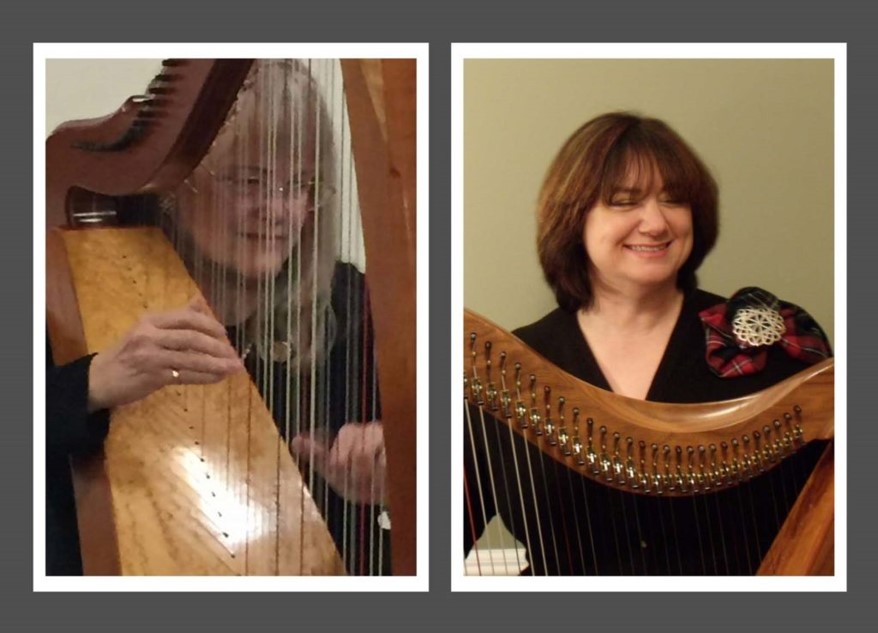 This year’s Quest will be focused on Looking Ahead. Our Quest will be easily accessible to harpers from anywhere and at any level and our focus will be a short and intense experience that we will each take with us into the coming months and years. We may not appreciate all we learned until much later – but secure in knowing that we will get there – each of us. And we’ll get there together!
This year’s Quest will be focused on Looking Ahead. Our Quest will be easily accessible to harpers from anywhere and at any level and our focus will be a short and intense experience that we will each take with us into the coming months and years. We may not appreciate all we learned until much later – but secure in knowing that we will get there – each of us. And we’ll get there together!
The Quest will occur in the beautiful and bucolic valleys of South Central PA 27 – 29 July. The setting is pastoral and relaxing – just the thing to learn and grow and go a little farther on the road we travel.
Kris and I will be your Guides and we are looking forward to a very personalized time of sharing and learning. We will have fun, support one another, and work together to get as much from our lever harps as we can get! We will work to expand technical skills and exercise our brains and as always, we will work on building healthy self-esteem, encouraging ourselves to try new things. We’ll start where each of us is and build on that to develop a better understanding of the skills necessary to continue going and growing. We’ll work individually and together experiencing three days of creativity, sharing, and fun.
The Quest is limited to only 10 spaces, so everyone gets personal attention, time to learn their own way, and has the space to flex their musical muscles. Interested in having a spot? For more information or a reservation form, Contact us.
Somerset Folk Harp Festival
Not long after OSAS – many of us gather again at the Somerset Folk Harp Festival*. Somerset has become a “must go” event for harp players! It is an amazing 4-day conference celebrating the diversity of music, talent and experience of the folk harp world. Whether you want to focus on one style or type of music, solidify some specific skills, or try out something new, there is something for you. The breadth of workshop offerings is sure to expand your musical horizon. The Exhibit Hall is the best harp and music shopping under one roof you’ll find anywhere on the East Coast. There are daily concerts that will inspire you. I strongly suggest that you plan to come for the whole festival but if you can only swing one day – do it! There are loads of registration options.
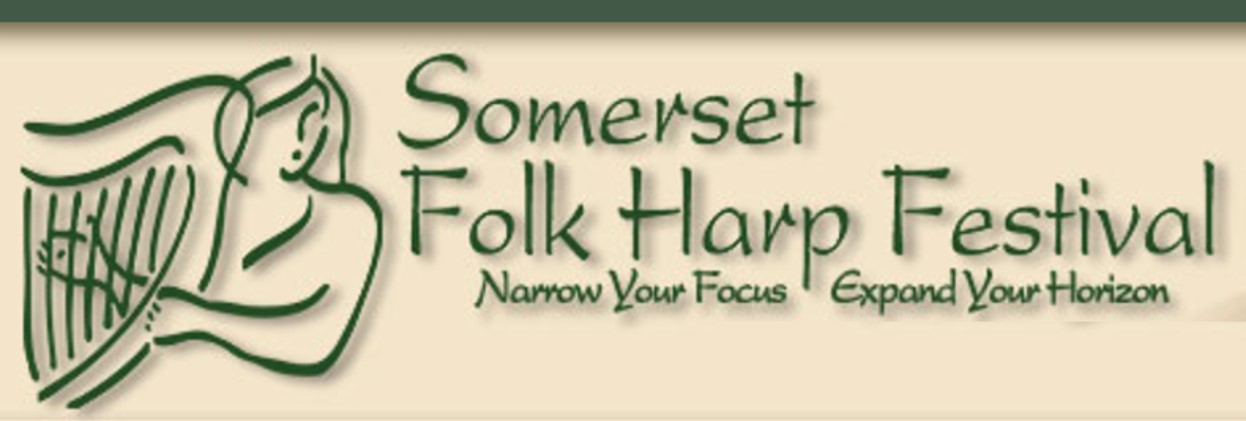 Somerset is coordinated by Kathy D’Angelo and is pulled off by a small but mighty band of people. But what makes it such a good way to spend your time? Well, I think they answer this well in a section entitled – What is the Festival Like? And the answer is – it’s awesome! It is like a three-ring circus, a harp feeding frenzy, a family re-union, and your wildest harp dreams come true! You get to meet and talk with and play with other people who are also addicted to harp. There’s time to swap “war stories” “craziest wedding stories” and “why I started to play the lever harp” stories. There are loads of good harpy things going on but the one thing that really makes the Festival so great is all the other harpers there! You will have an instant group of best friends at the Festival – including the stars of the harp world. You will find that you can talk with icons just as easily as you would talk with the other harpers in your harp circle. No matter what your level of harp experience, you will be welcomed most warmly and drawn into the family!
Somerset is coordinated by Kathy D’Angelo and is pulled off by a small but mighty band of people. But what makes it such a good way to spend your time? Well, I think they answer this well in a section entitled – What is the Festival Like? And the answer is – it’s awesome! It is like a three-ring circus, a harp feeding frenzy, a family re-union, and your wildest harp dreams come true! You get to meet and talk with and play with other people who are also addicted to harp. There’s time to swap “war stories” “craziest wedding stories” and “why I started to play the lever harp” stories. There are loads of good harpy things going on but the one thing that really makes the Festival so great is all the other harpers there! You will have an instant group of best friends at the Festival – including the stars of the harp world. You will find that you can talk with icons just as easily as you would talk with the other harpers in your harp circle. No matter what your level of harp experience, you will be welcomed most warmly and drawn into the family!
And – did I mention the Exhibit Hall? There’s loads of stuff to try, read through, buy, dream about, plan for, and take home including harps, CDs, sheet music, doo-dads, jewelry, artwork, music stands, carts, and more. And then there are the concerts which are designed to give you a diverse and broad exposure to the non-pedal harp world. There’s Celtic of course, but there’s also lots of other ethnic music, early music, classical, jazz, popular, and many sorts of harps including Paraguayan harps, bray harps, cross-strung harps, wire strung harps, double strung harps, harps with other instruments, and more! Diversity everywhere!
The workshops are incredible and span a wide range of levels and interests. Some of them are really substantive and challenging – some will pique your curiosity – some will inspire you to play better and some will be an occasion to let your hair down. The worst thing about the workshops is that you cannot take them all.
You do need to pace yourself! Somerset is held in Parsippany NJ 19 – 22 July and all the details are available at: http://www.somersetharpfest.com
*once again – all this content (except my gushing and comment) unceremoniously stolen directly from the Somerset website.
Although we’re still whinging on about the snow and cold, it’s already April and summer is fast approaching! This month I’ll highlight some of my favorite summer activities. If you want to attend any of these events, you’ll want to get a jump on it so you’re sure to get a place. Few things are worse than being excited to attend a workshop only to find out that it is sold out! I will present them in calendar order. These are events I really enjoy and have learned a lot from. There is no affiliate marketing (i.e. kickback) only the potential benefit of possibility of running into you at one of these events!
Let’s start with the
Ohio Scottish Arts School*!
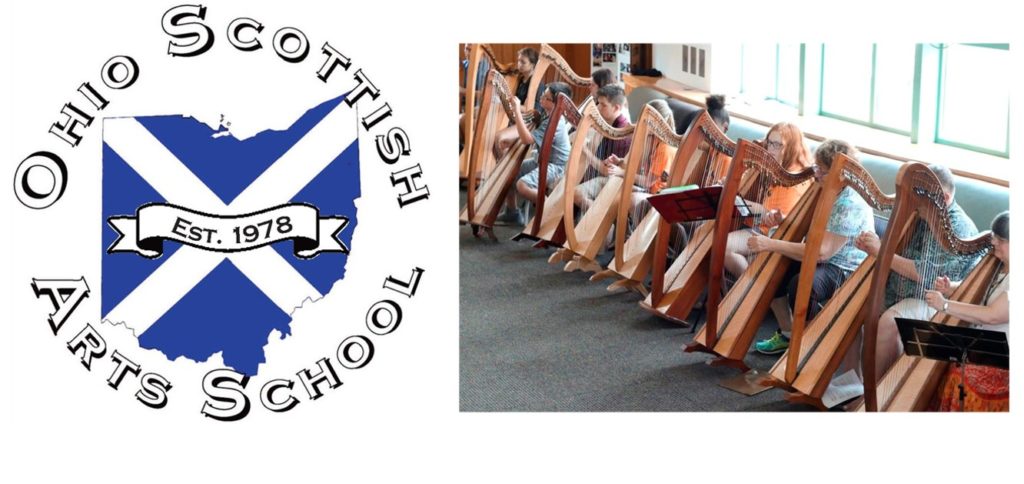 This is the 40th Anniversary of the Ohio Scottish Arts School! (you also have the opportunity to help celebrate this momentous anniversary here – donate $40 for 40th Anniversary)
This is the 40th Anniversary of the Ohio Scottish Arts School! (you also have the opportunity to help celebrate this momentous anniversary here – donate $40 for 40th Anniversary)
OSAS has been an excellent hub for meeting the greats (and future greats) of Scottish Harp in the US and UK – some as instructors, some as students (and later as instructors). It is a fun and intensive week. The (harp) classes will focus on basic harp technique (for beginners and intermediates), repertoire at all levels, including tunes for competition sets, Scottish style, including ornaments, lilt, and dance types. Every day you study Scottish dance music, airs, and songs, ornamentation, Scottish style, accompaniment, and learning by ear. Each day there are lectures, practice time, and playing in sessions. If you play the harp, there’s a class for you! Classes are available for beginners (who have played for a few months), as well as intermediate and advanced players.
In the evenings there are activities (and snacks!) and you can always join (or start) a session. The harpers have become spoiled by the students of Ringgold Middle and high schools who prepare and share a lovely mid-week Tea – an event to which we all look forward!
OSAS is a fun, exciting workshop chock full of stuff you want to know. Some participants have been coming for years. And, lest you think this sounds like summer camp – it is! But with a delightful twist and students – kids and adults – really enjoy the week.
Of course, perhaps the most important thing to know is who will be teaching – and this year has an outstanding line up (again!). Sue Richards organizes and is the coordinating teacher (www.suerichards.net), Gillian Fleetwood is coming from Scotland for a second year! (gillianfleetwood.com),Seumas Gagne returns after a few years away doing amazing things! (www.seumasgagne.com/), and me! I am delighted to be teaching at OSAS again this year and to be working with such exceptional people! I keep pinching myself over my good fortune.
The 40th Ohio Scottish Arts School will be held June 23-29, 2018 – don’t miss it! For more information and to register go to http://ohioscottishartsschool.com/. See you there?
* except for the occasional comment, all this information (including the photos) is unceremoniously lifted from the OSAS website
It’s July and we’re about half way through the year. It is a good time to check in and see how we’re doing. While it is a good exercise to review goals, it is also an excellent time to review other important things. Especially those that we take for granted and think are taking care of themselves! Let’s start with….Posture!
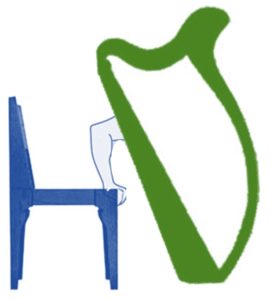 Your posture really is the core of all your playing. That’s not just a play on words. Being able to hold yourself upright and to keep your arms up but relaxed, your hands in an appropriate position, and keep your core tight all take work. Are you ready for that work?
Your posture really is the core of all your playing. That’s not just a play on words. Being able to hold yourself upright and to keep your arms up but relaxed, your hands in an appropriate position, and keep your core tight all take work. Are you ready for that work?
There are numerous resources available providing methods for strengthening your core. By incorporating appropriate exercises to strengthen your core you’ll be able to sit up straight with good balance for as long as needed with less fatigue. That means that your next long background gig will be easier. And your long practice session will definitely be easier to sit through. Your core works while you’re sitting and supports your back and your hips. A strong core will also help you avoid curling into the harp while you’re playing which can cause strain on the neck and increasing the possibility of injuring yourself. It also will provide you with the stable base from which you can build your good technique.
Of course, a strong core will also be good for you away from the harp assuring your balance and stability are better whether you’re carrying your harp or walking down the street. Strengthening your core isn’t just sit ups! Spend a little time online to learn ways to get stronger so you can play as long as you like!
* I am, of course, not an exercise physiologist or a physician – but you already knew that! Consult your physician before undertaking any exercise program. Don’t do any of this if your physician tells you not to. Seek specific advice from qualified individuals. This information is presented for educational purposes only. It does not replace or substitute professional advice from your physician, certified trainer, or any other health-care professional. Use of the information on this site is solely at your own risk. Don’t be daft – get the right help and don’t hurt yourself!